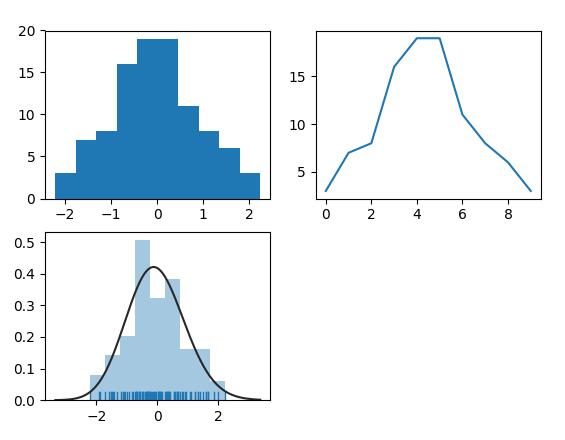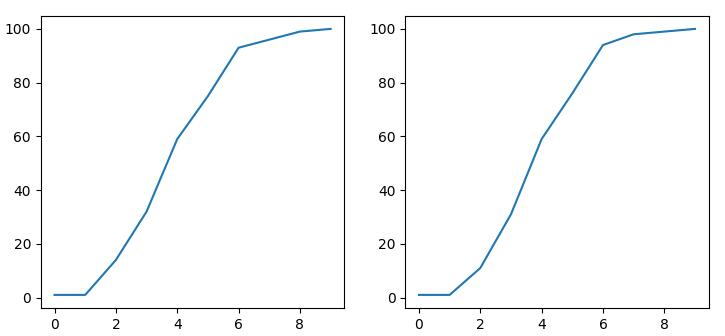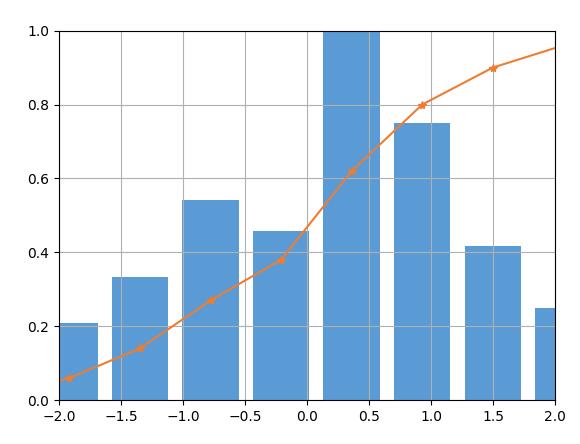жӮЁеҘҪпјҢзҷ»еҪ•еҗҺжүҚиғҪдёӢи®ўеҚ•е“ҰпјҒ
жӮЁеҘҪпјҢзҷ»еҪ•еҗҺжүҚиғҪдёӢи®ўеҚ•е“ҰпјҒ
иҝҷзҜҮж–Үз« з»ҷеӨ§е®¶еҲҶдә«зҡ„жҳҜжңүе…іPythonеҰӮдҪ•еӨ„зҗҶPDFдёҺCDFзҡ„еҶ…е®№гҖӮе°Ҹзј–и§үеҫ—жҢәе®һз”Ёзҡ„пјҢеӣ жӯӨеҲҶдә«з»ҷеӨ§е®¶еҒҡдёӘеҸӮиҖғпјҢдёҖиө·и·ҹйҡҸе°Ҹзј–иҝҮжқҘзңӢзңӢеҗ§гҖӮ
еңЁжӢҝеҲ°ж•°жҚ®еҗҺпјҢжңҖйңҖиҰҒеҒҡзҡ„е·ҘдҪңд№ӢдёҖе°ұжҳҜжҹҘзңӢдёҖдёӢиҮӘе·ұзҡ„ж•°жҚ®еҲҶеёғжғ…еҶөгҖӮиҖҢй’ҲеҜ№ж•°жҚ®зҡ„еҲҶеёғпјҢеҸҲеҢ…жӢ¬pdfе’ҢcdfдёӨзұ»гҖӮ
дёӢйқўд»Ӣз»ҚдҪҝз”Ёpythonз”ҹжҲҗpdfзҡ„ж–№жі•пјҡ
дҪҝз”Ёmatplotlibзҡ„з”»еӣҫжҺҘеҸЈhist()пјҢзӣҙжҺҘз”»еҮәpdfеҲҶеёғпјӣ
дҪҝз”Ёnumpyзҡ„ж•°жҚ®еӨ„зҗҶеҮҪж•°histogram()пјҢеҸҜд»Ҙз”ҹжҲҗpdfеҲҶеёғж•°жҚ®пјҢж–№дҫҝиҝӣиЎҢеҗҺз»ӯзҡ„ж•°жҚ®еӨ„зҗҶпјҢжҜ”еҰӮиҝӣдёҖжӯҘз”ҹжҲҗcdfпјӣ
дҪҝз”Ёseabornзҡ„distplot()пјҢеҘҪеӨ„жҳҜеҸҜд»ҘиҝӣиЎҢpdfеҲҶеёғзҡ„жӢҹеҗҲпјҢжҹҘзңӢиҮӘе·ұж•°жҚ®зҡ„еҲҶеёғзұ»еһӢпјӣ

дёҠеӣҫжүҖзӨәдёәйҮҮз”Ё3з§Қз®—жі•з”ҹжҲҗзҡ„pdfеӣҫгҖӮдёӢйқўжҳҜжәҗд»Јз ҒгҖӮ
from scipy import stats import matplotlib.pyplot as plt import numpy as np import seaborn as sns arr = np.random.normal(size=100) # plot histogram plt.subplot(221) plt.hist(arr) # obtain histogram data plt.subplot(222) hist, bin_edges = np.histogram(arr) plt.plot(hist) # fit histogram curve plt.subplot(223) sns.distplot(arr, kde=False, fit=stats.gamma, rug=True) plt.show()
дёӢйқўд»Ӣз»ҚдҪҝз”Ёpythonз”ҹжҲҗcdfзҡ„ж–№жі•пјҡ
дҪҝз”Ёnumpyзҡ„ж•°жҚ®еӨ„зҗҶеҮҪж•°histogram()пјҢз”ҹжҲҗpdfеҲҶеёғж•°жҚ®пјҢиҝӣдёҖжӯҘз”ҹжҲҗcdfпјӣ
дҪҝз”Ёseabornзҡ„cumfreq()пјҢзӣҙжҺҘз”»еҮәcdfпјӣ

дёҠеӣҫжүҖзӨәдёәйҮҮз”Ё2з§Қз®—жі•з”ҹжҲҗзҡ„cdfеӣҫгҖӮдёӢйқўжҳҜжәҗд»Јз ҒгҖӮ
from scipy import stats import matplotlib.pyplot as plt import numpy as np import seaborn as sns arr = np.random.normal(size=100) plt.subplot(121) hist, bin_edges = np.histogram(arr) cdf = np.cumsum(hist) plt.plot(cdf) plt.subplot(122) cdf = stats.cumfreq(arr) plt.plot(cdf[0]) plt.show()
еңЁжӣҙеӨҡж—¶еҖҷпјҢйңҖиҰҒжҠҠpdfе’Ңcdfж”ҫеңЁдёҖиө·пјҢеҸҜд»ҘжӣҙеҘҪзҡ„жҳҫзӨәж•°жҚ®еҲҶеёғгҖӮиҝҷдёӘе®һзҺ°йңҖиҰҒжҠҠpdfе’ҢcdfеҲҶеҲ«иҝӣиЎҢеҪ’дёҖеҢ–гҖӮ

дёҠеӣҫжүҖзӨәдёәеҪ’дёҖеҢ–зҡ„pdfе’ҢcdfгҖӮдёӢйқўжҳҜжәҗд»Јз ҒгҖӮ
from scipy import stats import matplotlib.pyplot as plt import numpy as np import seaborn as sns arr = np.random.normal(size=100) hist, bin_edges = np.histogram(arr) width = (bin_edges[1] - bin_edges[0]) * 0.8 plt.bar(bin_edges[1:], hist/max(hist), width=width, color='#5B9BD5') cdf = np.cumsum(hist/sum(hist)) plt.plot(bin_edges[1:], cdf, '-*', color='#ED7D31') plt.xlim([-2, 2]) plt.ylim([0, 1]) plt.grid() plt.show()
ж„ҹи°ўеҗ„дҪҚзҡ„йҳ…иҜ»пјҒе…ідәҺвҖңPythonеҰӮдҪ•еӨ„зҗҶPDFдёҺCDFвҖқиҝҷзҜҮж–Үз« е°ұеҲҶдә«еҲ°иҝҷйҮҢдәҶпјҢеёҢжңӣд»ҘдёҠеҶ…е®№еҸҜд»ҘеҜ№еӨ§е®¶жңүдёҖе®ҡзҡ„её®еҠ©пјҢи®©еӨ§е®¶еҸҜд»ҘеӯҰеҲ°жӣҙеӨҡзҹҘиҜҶпјҢеҰӮжһңи§үеҫ—ж–Үз« дёҚй”ҷпјҢеҸҜд»ҘжҠҠе®ғеҲҶдә«еҮәеҺ»и®©жӣҙеӨҡзҡ„дәәзңӢеҲ°еҗ§пјҒ
е…ҚиҙЈеЈ°жҳҺпјҡжң¬з«ҷеҸ‘еёғзҡ„еҶ…е®№пјҲеӣҫзүҮгҖҒи§Ҷйў‘е’Ңж–Үеӯ—пјүд»ҘеҺҹеҲӣгҖҒиҪ¬иҪҪе’ҢеҲҶдә«дёәдё»пјҢж–Үз« и§ӮзӮ№дёҚд»ЈиЎЁжң¬зҪ‘з«ҷз«ӢеңәпјҢеҰӮжһңж¶үеҸҠдҫөжқғиҜ·иҒ”зі»з«ҷй•ҝйӮ®з®ұпјҡis@yisu.comиҝӣиЎҢдёҫжҠҘпјҢ并жҸҗдҫӣзӣёе…іиҜҒжҚ®пјҢдёҖз»ҸжҹҘе®һпјҢе°Ҷз«ӢеҲ»еҲ йҷӨж¶үе«ҢдҫөжқғеҶ…е®№гҖӮ